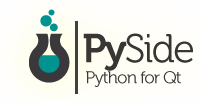PySide
 | |
| Original author(s) | Openbossa |
|---|---|
| Developer(s) | Qt Project |
| Initial release | 18 August 2009[1] |
| Stable release | 1.2.4
/ 14 October 2015 |
| Written in | Python |
| Operating system | Cross-platform[which?] |
| License | LGPL |
| Website | www |
PySide is a Python binding of the cross-platform GUI toolkit Qt. It is one of the alternatives to the standard library package Tkinter. Like Qt, PySide is free software. The project started out using Boost.Python from the Boost C++ Libraries for the bindings and later switched to the binding generator Shiboken[2] to reduce the size of the binaries and the memory footprint.
PySide was released under the LGPL in August 2009 by Nokia,[1] the former owners of the Qt toolkit, after Nokia failed to reach an agreement with PyQt developers Riverbank Computing[3] to change its licensing terms to include LGPL as an alternative license.
PySide supports Linux/X11, Mac OS X, Windows and Maemo. Support for Android and Symbian is currently being added by the PySide community.[4]
Hello world example
import sys
from PySide import QtGui
app = QtGui.QApplication(sys.argv)
win = QtGui.QWidget()
win.resize(320, 240)
win.setWindowTitle("Hello, World!")
win.show()
sys.exit(app.exec_())
See also
References
- ^ a b PySide has been released, August 18th, 2009 – PySide – Python for Qt. Template:Wayback
- ^ "Shiboken". Pyside.org. Retrieved 2010-05-25.
- ^ "FAQ – PySide – Python for Qt". Pyside.org. Retrieved 2015-05-04.
- ^ "Which platforms is PySide available for? FAQ – PySide – Python for Qt". Pyside.org. Retrieved 2015-05-04.
External links
